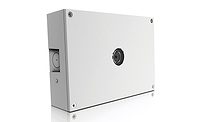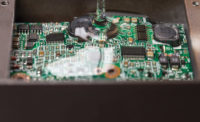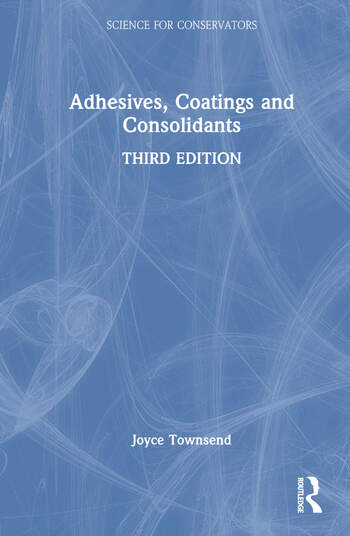Advancing Adhesives
Solving Engineering Challenges with Functional Coatings
Teflon™ and other functional coatings can solve design problems including excessive wear, sticking, noise, and corrosion.

Teflon, or polytetrafluoroethylene (PTFE), is one of the most versatile industrial coatings available today. Best known for its nonstick properties, Teflon offers an extremely low coefficient of friction, chemical inertness, and excellent dielectric stability. Far more than a product for cookware, Teflon’s non-stick properties can be used to solve a variety of design challenges, including preventing the buildup of contaminants, corrosion and bacteria, and reducing friction or sticking between parts that come into contact. It can also be used as an ingredient in heavy-wear, high-load applications.
“Teflon is the ultimate ‘problem solver’ for design issues that can include sticking, release, wear, noise and abrasion,” says George Osterhout of Orion Industries, one of the largest Chemours-licensed applicators for Teflon coatings in North America. “Engineers often seek assistance when they are experiencing problems, whether it’s a part that has no coating or a coating that isn’t performing as expected.”
According to Osterhout, substrates that can be coated with Teflon include carbon steel, aluminum, stainless steel, steel alloys, brass, titanium and magnesium, as well as glass, fiberglass, silicone rubber, rubber and plastics. A short list of products that are coated includes cookware, supercharger rotors, automotive throttle shafts, solenoids, airplane toilet bowls, the exterior of light bulbs, rubber O-rings, and the rollers used to cook hot dogs in convenience stores.
Precision Application
The application of Teflon and other functional coatings has advanced into a precise, highly automated operation. Due to the investment in production equipment and the rigors of meeting environmental regulations, applicators of Teflon coatings are partnering with companies that previously performed this work in their own facilities or that used to job it out to local applicators.
According to Osterhout, the difference in quality between applicators is usually defined by two primary factors: the proper and thorough pretreatment of parts prior to coating, and the ability to apply precise thickness of coatings as low as 10 microns with little to no variance between parts and at a tolerance of ± 3 microns. The industrial norm is 10-20 microns per side of coating.
To ensure that level of precision, applicators must design and build their own production lines from the ground up. Furthermore, these systems must be configured to be flexible enough to accommodate a range of parts in different sizes and geometries. For example, Orion uses a flexible cellular manufacturing approach to speed production for a variety of parts, while controlling the material cost and energy. The stationary equipment or robotic cell is moved into position and allows the coatings to be applied exactly to specification while using conveyers and ovens to do the flash and curing process or to completely cure the part. The parts are coated in these cells with very little overspray and coating waste.
“In our process, we meter the coating material out of the gun so it is the same every single time,” says Osterhout. “There is very little overspray because we apply the coating where it needs to be, not all over the coating booth.” By using infrared ovens mixed with convection air ovens, parts can often be cured three times faster than with traditional convection ovens.
More than Food
Although Teflon is very popular as a highly durable and reliable coating for cookware, its nonstick qualities can be just as important for preventing the accumulation of foreign particles, contaminants, and wear properties. In many applications, the buildup of dirt, ice, soot, scale food and other foreign material can prevent the proper function of machine or engine components. If contamination of a surface is anticipated, it can be minimized with thin Teflon coatings.
Teflon’s nonstick properties make it an excellent corrosion barrier as well. Coated parts can be used to prevent galvanic corrosion and shed corrosive fluids like salt water, process chemicals, fuels, and lubricants. Today’s formulations can also include antimicrobial agents that can benefit a range of applications.
Conformable Coatings
For applications where very tight clearances between parts are required, such as rotary screw compressors, Teflon-based conformable coatings can be used to narrow the gap without allowing metal-to-metal contact during operation. Decreasing the gap can reduce noise, stop air or fluid leakage, or create a tighter hydrodynamic seal. In the case of rotary screw compressors, a conformable coating can increase efficiency by over 10% or more without changing machining tolerances.
Ultra-thin conformable coatings contain a mixture of polyimide and other resins. The formulation contains nanometer-sized wear-resisting particles, as well as PTFE. The coating is applied in thicknesses specified during initial design and testing, such that the two coated surfaces initially contact each other while allowing the tips clearance to pass in a rotary screw application.
Small air pockets in the polymer allow the coating to compress under mechanical pressure. Once compressed, the air pockets remain crushed so the coating holds the new profile. The PTFE in the formulation prevents the surfaces from galling or sticking to each other during this initial contact. This is a superior alternative to surface hardening, which only delays galling, or more precise machining of parts with extremely tight tolerances. Given the extremely tight clearance, these conformable coatings must hold ± 0.001 in. tolerance on all surfaces at a thickness of 0.002-0.006 in.
Low-Friction Coatings
In addition to being a licensed applicator of Teflon coatings, some manufacturers have developed their own line of proprietary coatings. For example, one coating* has been designed to reduce the coefficient of friction of molded silicone rubber from 20-60%. In addition, it also aides in reducing the collection of dust or dirt on the finished coated surface.
Silicone rubber, though widely used for tubes, seals and rollers, is tacky and can cling to any object it comes in contact with—even other silicone surfaces. This is due to the materials high friction coefficient, which can exceed 1.0. To lower the coefficient of friction on the surface of silicone parts, many applications use a Parylene coating that utilizes a chemical vapor deposition process to form a physical bond. However, Parylene is rigid, can crack and has no antimicrobial properties. Furthermore, only process parts that fit in the vapor chamber can be coated and interior dimensions are very difficult to coat.
Orion’s coating provides a chemical bond to silicone rubber to reduce the coefficient of friction. Due to its excellent elongation properties, the coating does not crack and antimicrobial properties can be added.
Dry Film Lubricants
Engineers are typically schooled in oil- or grease-based lubrication techniques, but not nearly as much time or attention is spent on dry film lubricants. Unlike oil and grease, which can migrate away, dry film lubricants continue to transfer back and forth on the mating surfaces and stay in place for a much longer time. In addition, dry film coatings serve as a thin cushion, spreading high point loads in bearings and reducing element fatigue. For this, graphite and molybdenum disulfide (moly-disulfide) are often used. Moly-disulfide coatings are recommended for conditions of heavy wear, particularly high-load situations. This includes bearing-type applications where one part rolls or slides over another part. Graphite coatings are generally used in wet service or at elevated temperatures.
Teflon can also serve a dry film lubricant, though typically for light to moderate applications. Teflon is often incorporated with moly-disulfide and graphite for unique formulations.
R&D Laboratory Access
Osterhout admits the variety of coating formulations and range of products that could benefit is daunting. In many cases, engineers have product with no coating, or a coating that isn’t performing as expected, and need a resource to explore the options. “Engineers need to establish how the Teflon coating is going to function, and they also need to know the thickness that will be applied to compensate for it to fit within their existing dimensions,” he says.
To assist in developing specialized materials and application methods, a few applicators now maintain in-house R&D laboratories to test new coatings available on the market and develop their own for specific customer applications.
Some labs are equipped with the latest QC equipment for testing wear, lubrication, coefficients of friction and other key application parameters. In addition, customers and prospects can consult with in-house engineering staff when custom coatings are required.
One of the benefits of having an in-house lab, says Osterhout, is that “We have access to baseline performance information from past research and experimentation so we can compare one coating to another that we have developed. This allows us to know that we made substantial performance improvements in the new coatings.” ASI
For more information, phone (773) 282-9100, e-mail info@orioncoat.com or visit www.orioncoat.com.
*FluoroBond LSR
Looking for a reprint of this article?
From high-res PDFs to custom plaques, order your copy today!







